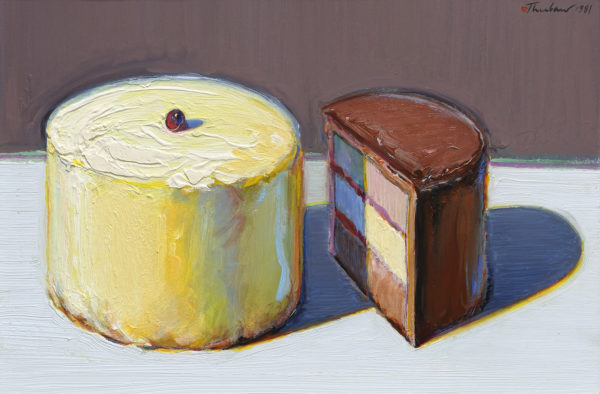Along with everyone else, I was always thrilled to see another painting of Wayne Thiebaud’s cars screeching up and down the insane hills of San Francisco in one traffic jam after another, melting into another modern painting of man’s insanity. However, when I finally crashed into Thiebaud’s next subject matter, a varied selection of pies and cakes, and even cupcakes, I felt like I had just hit a brick wall. How demeaning, how embarrassing—was he on some strange diet, the fat diet?
The obsessive way some people talk about food—what kind of food, what restaurant, what their mothers cooked—when coupled with the beautiful way this artist handled paint, made for a combination of disgust and glorious sensuality. The combo was wrenching. I couldn’t wait for the next beautiful painting of more desserts. Didn’t Warhol paint Coke bottles and soup cans? Subject matter is important to the artist and dessert is important to us, Goddamn it. It’s American… isn’t it? Well, maybe it’s French.

Camellia Cake, 1995
I confess, my snobby mind was shocked. But my body loved it in a greedy kind of fashion—slurp, gobble and yet so gorgeously painted—my God, I would rather look at it than eat it. Then I became skeptical. We had come a long way from the lavish mounds of dead animal carcasses surrounded by red apples and dappled with green grapes, presented on a splendid mahogany table, in a rich brown gravy moat—the veritable castles of food rendered by old masters.

Cake Slice, 1979
Thiebaud was just giving us the modern version to drool over: a glacier of chipped ice under a thick uninviting sky of cold glass. Little boats of cheap porcelain struggled in vain to sail out of our reach, each one bearing a narrow slice of desperate cake trying to hide under gobs of Technicolor icing, a seductive flotilla of death caught under the fluorescent moon, whose one and only job was to kill you with sugar. And we were excited. We started to salivate but it was only a painting. We thought about ice cream (a milder form of death) and for a moment our childhood played in the back yard of our mind. Now we had to have this painting; it was necessary. Forget Picasso and being uncomfortable, I just wanted a piece of fucking CAKE. I wanted to eat with my eyes and remember all the stupid fun I’d had in this country. Thank you, Wayne.


